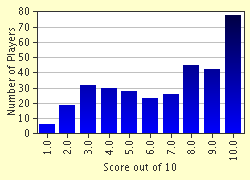Quiz Answer Key and Fun Facts
1. "The Killing Joke" opens with Batman visiting the Joker in Arkham Asylum, Gotham City's repository for its most dangerous criminals. Why has Batman come to see the Joker?
2. To carry out the plot that forms the backbone of this story, the Joker purchases a rundown amusement park. How does he pay for the park?
3. During a series of flashbacks, we learn how the Joker came to be. In the weeks prior to taking up a life of crime, what was the Joker's chosen profession?
4. In perhaps the story's most shocking turn, the Joker kidnaps Commissioner Jim Gordon, intending to drive him insane as an object lesson. What major recurring character does the Joker shoot during the abduction, severing the victim's spinal cord?
5. As we return to the series of flashbacks, we learn that the man who would become the Joker (his name is never disclosed in the story) was recruited by a gang to rob his former place of employment. As part of the gang's strategy, the Joker is coerced into assuming a putative "super-villain" identity. What guise is this?
6. As the flashbacks conclude, we learn that Batman foiled the Joker's first foray into crime. Which of these events on that day seemingly pushed the Joker into irreversible madness?
7. The Joker intends to drive Commissioner Gordon mad to prove, as he says, that "all it takes is one bad day to drive the sanest man alive to lunacy". Which of these are among the traumas the Joker inflicts on Gordon?
8. In tracking down the Joker, Batman refers to the therapist's notes from the Joker's stay at Arkham wherein the Clown Prince has confided the story of his "one bad day".
9. By the time Batman rescues Commissioner Gordon, he is thoroughly shattered by the Joker's tortures. Batman remarks that it may take years for Gordon to regain his mental health.
10. At the end of the story, having effectively subdued the Joker, Batman offers that "it doesn't have to be this way" and that the Joker may be still be able to return to a relatively normal life - with Batman's personal assistance. The Joker sadly retorts that it is far too late for that, that madness is his only way to escape the insanity of normal life, and concludes by telling Batman a morbid joke about "two guys in a lunatic asylum". Batman's predictable initial response is to stare impassively. How does Batman then react?
Source: Author
stuthehistoryguy
This quiz was reviewed by FunTrivia editor
linkan before going online.
Any errors found in FunTrivia content are routinely corrected through our feedback system.

